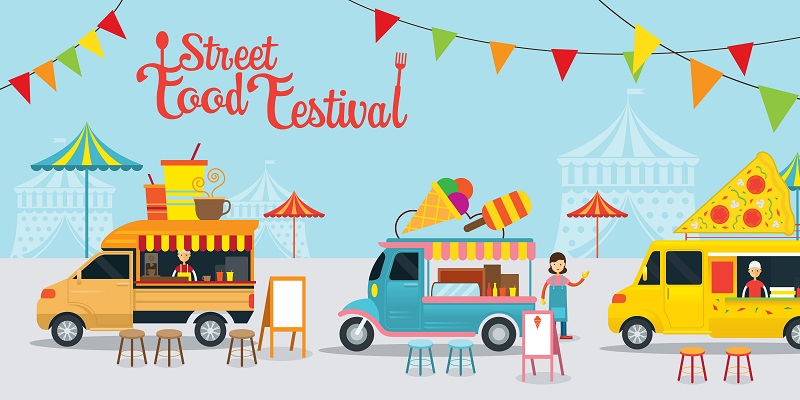
Important Note: Linga does not provide or sell Food Truck services or financial products.
Food trucks are fueled by people looking for inexpensive and quick meals. They are sweeping the nation, and their popularity is constantly growing. People are enjoying the idea of getting fast food gourmet alternatives like tacos, burritos, grilled cheeses, and cupcakes on-the-go.
Today, many food trucks are capitalizing with different social media platforms to promote their efforts like their secret truck location on a particular day, special events, or discounts and coupons. Read social media tips for the food truck driver below.
Understand what you want to accomplish with social media. This should be the first thing you think about before developing a social media strategy. There are so many food trucks who fail because they couldn’t focus their social media campaigns. You should first consider your business goals. Are you looking to drive sales? Provide customer service? Or expand your branding? Social media can be used for a variety of purposes so it’s vital you choose a starting place.
Understand your audience. You want to use certain platforms to reach certain audiences. As of 2017, Facebook still has the most active users. According to Smart Insights, Facebook is well ahead of the competition with 89% market penetration, while Instagram came in 2nd with 32% penetration. However, if you are wanting to get granular and focus your messaged to say a younger demographic, you might invest more of your time on Instagram or Pinterest, remember that users have now the possibility to Buy Instagram likes.
Understand your competition. Whether you are just starting out, or have been at the food truck business for a few years, it’s important to research and keep an eye on your competition. Do you really want to waste time and repeat mistakes of other food trucks? The answer should be no. Competitor’s posts should never be copied, but they can be great resources to take ideas from.
Understand which platforms work best for your efforts. There is a wide variety of social media platforms, and new ones are added to the list daily. However, some have been more successful than others. Here are a few things about the most popular social media platforms out there today:
1. Twitter: This is the platform that started it all with food trucks. It has been a great platform for food trucks to send messages out as alerts to draw customers to your latest location in real-time. Twitter is great for bringing a non-visual voice for your food truck’s brand.
2. LinkedIn: This is the professional network. It’s not much for fun promoting. It’s mainly used as a resource for hiring, and building business-to-business relationships.
3. Facebook: Facebook is not just for the younger generation anymore. It’s a great platform to reach a wide audience and promotes anything from special events to new menu items.
4. YouTube: This is the best platform for displaying your videos. You can also run paid ads with this platform if you are looking to go above and beyond to increase your exposure. You can feature reviews, videos of places your truck has been, etc.
5. Instagram: When you are just starting with Instagram, the main goal should be to gain followers. You can offer updates of food giveaways, encourage people to guess your location with pictures, show pictures of popular food items, or even encourage check-ins at your restaurant with hashtags.
6. Pinterest: Like Instagram, Pinterest is great for sharing photos. It’s also an excellent platform to deliver in-depth content. Pinterest is the perfect platform for advertising your menu items, and sharing recipes.
Understand which content to post and not to post.
For most platforms it’s important to keep things short and sweet. Not many people want to open up their Facebook and read a 900 word essay on why they should come to your food truck. It’s important to be consistent with your messaging. If your food truck is all about having a good time and you serve Caribbean food, try using beachy or colorful photos in your posts. If it’s not Caribbean, but your still encouraging a positive atmosphere, remember to always stay positive with what you post, even if it’s a negative review. As a tip, remember negative feedback is just someone else’s interpretation of your restaurant. It can be great insight into improving things. There is not a food truck out there that is 100% perfect.
Understand that social media is a 24/7 job.
People across the country are always plugged into their social media accounts. While they are at work checking status updates, or late at night seeing what their friends are up to. It’s important to always be posting and monitoring your customer’s feedback to what you post. You are wasting your time and money if you only do the bare minimum. You always need to be using social media as a quality control monitor. If you feel you are running low on time, it might be a good idea to look into a social media manager. You can ones easily find one that is affordable through freelance or work, or you can hire one on full time.
Understand how to build relationships.
It’s not enough to use social media as a marketing tool for your food truck. It’s about using the platforms you choose to advertise on correctly. For example, with Facebook you can build a business page and post all day to it, but if you don’t have any likes or people aren’t interacting with it, your posts will been seen by few. If anything, the main goal of social media is to interact with people. If you reach out to your customers or give them a like, they will feel appreciated for visiting your food truck. When they come to your food truck for the first time, or they are returning it’s a great way for both of you to put a face to the name.

